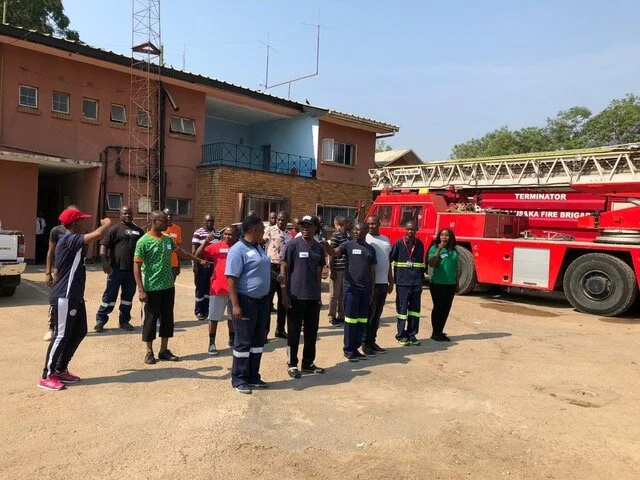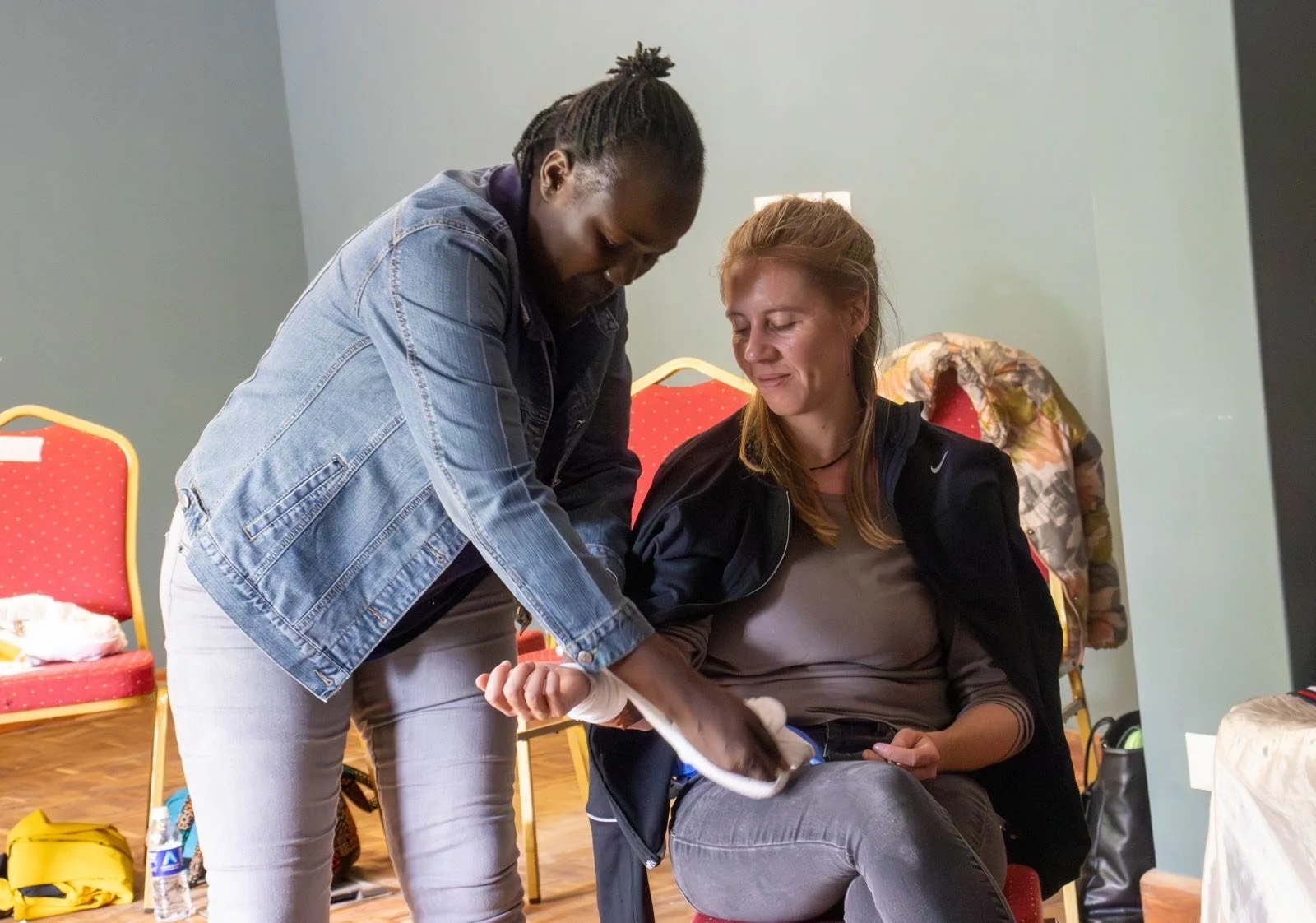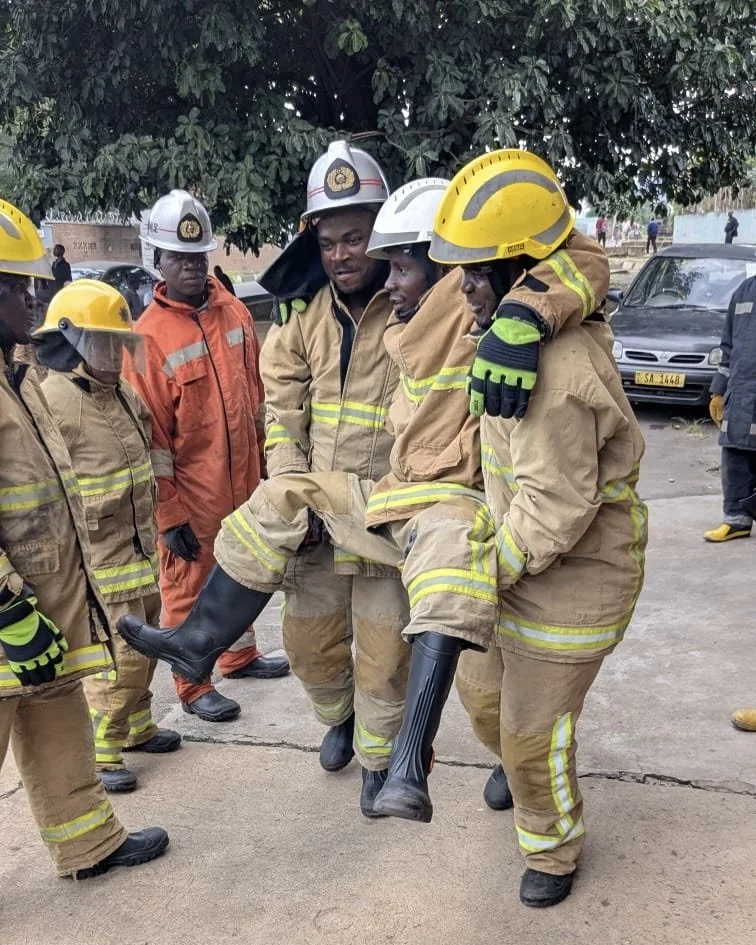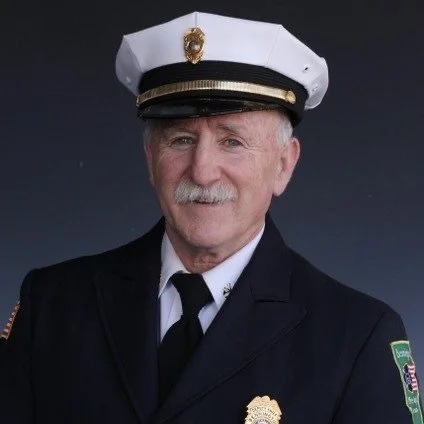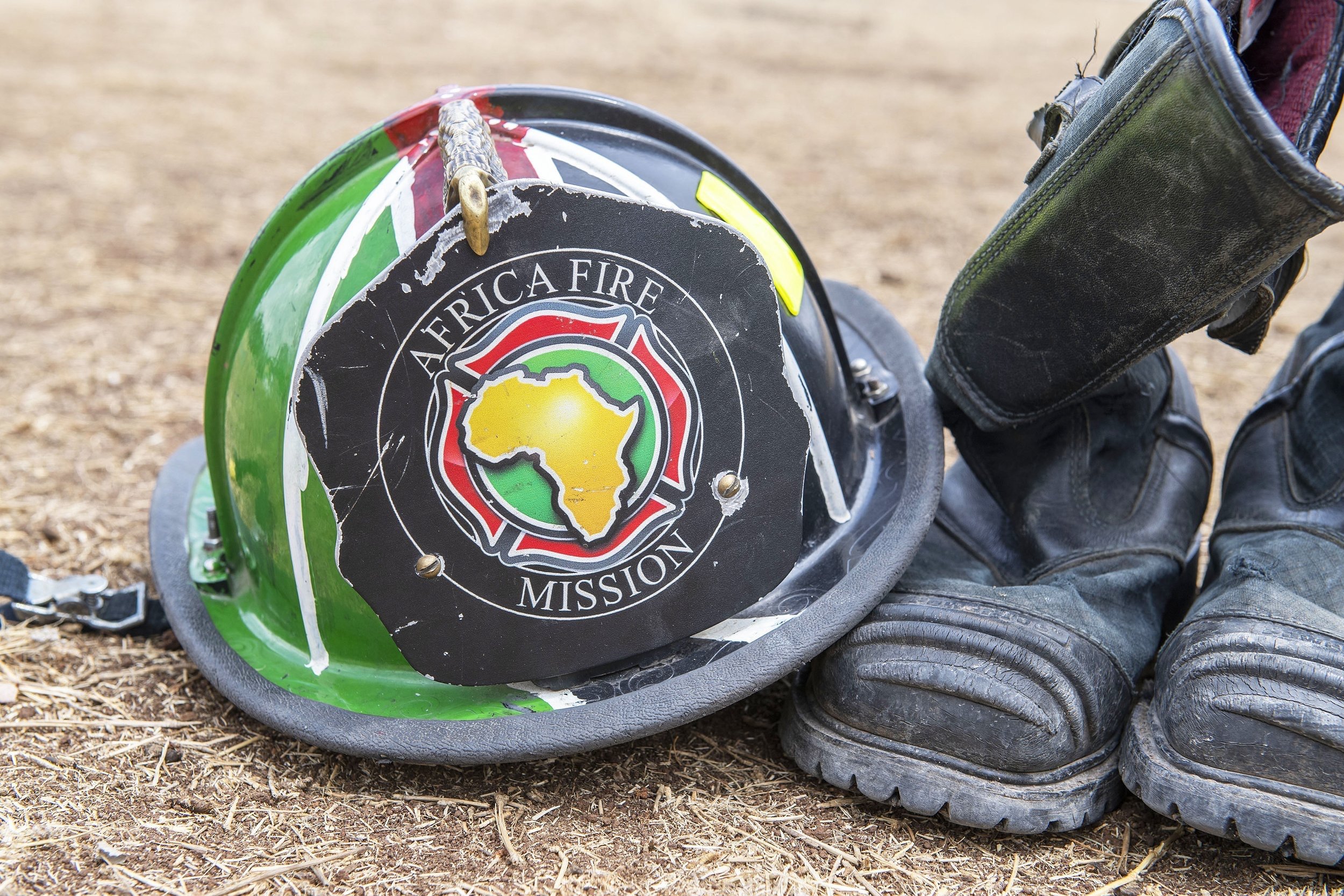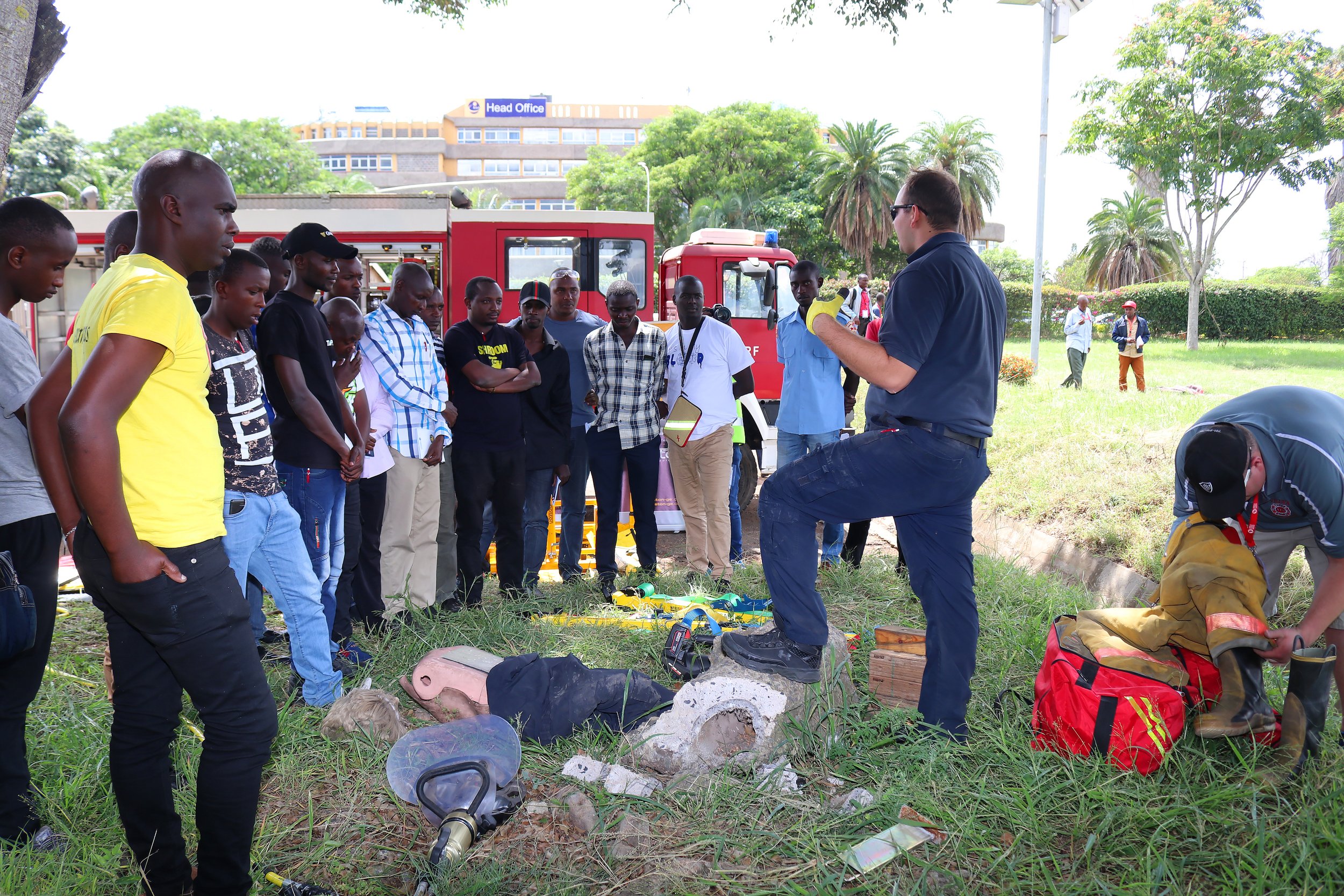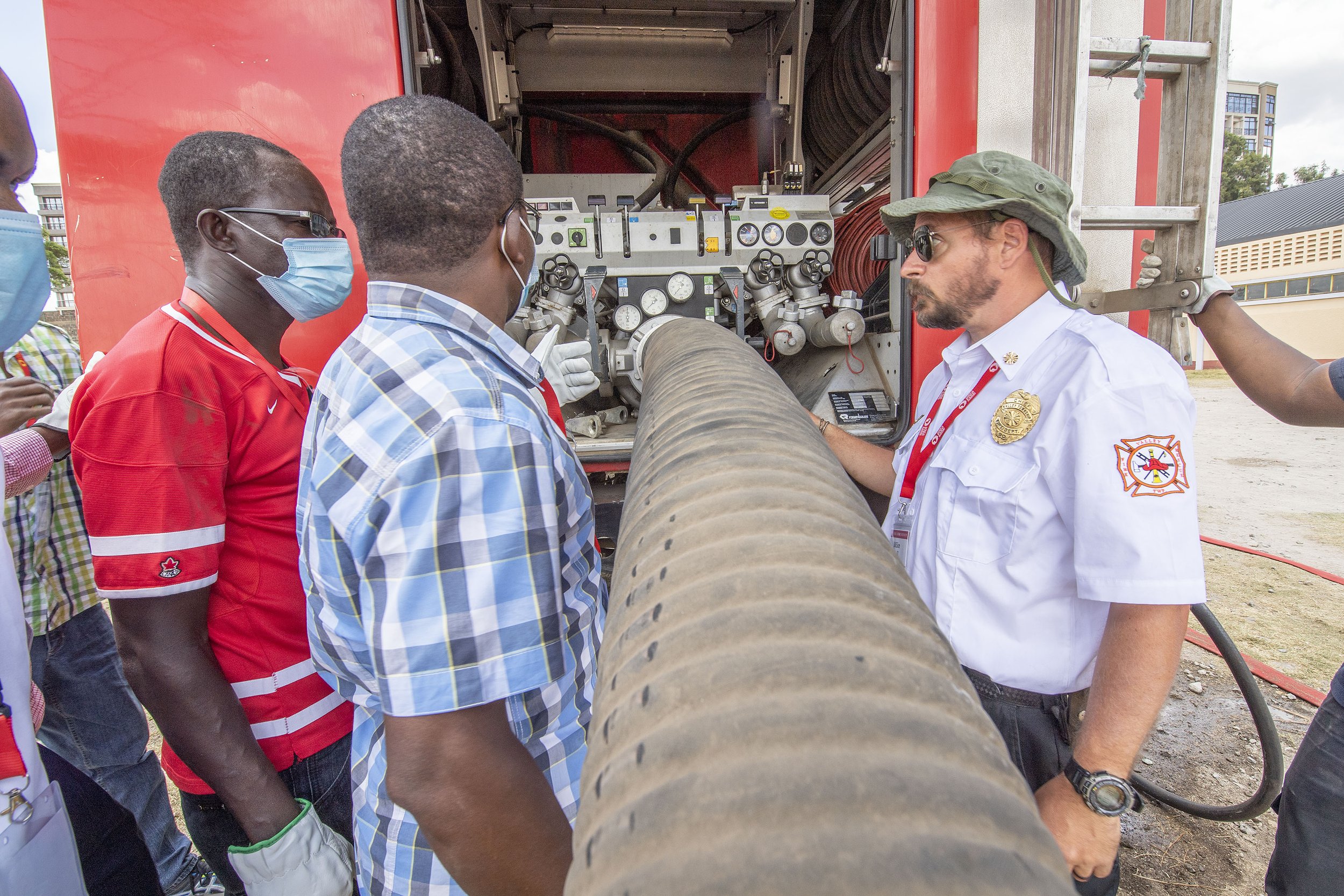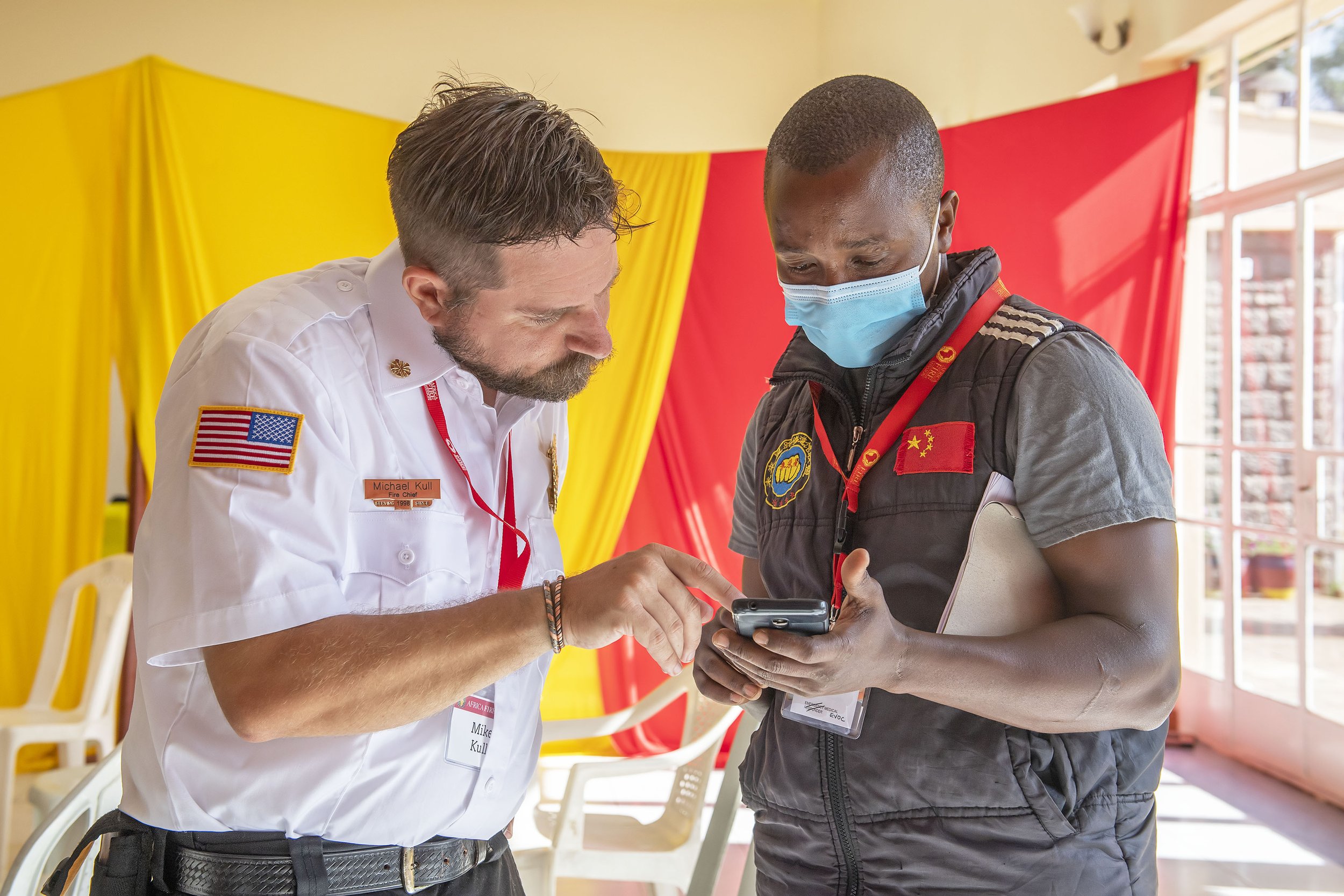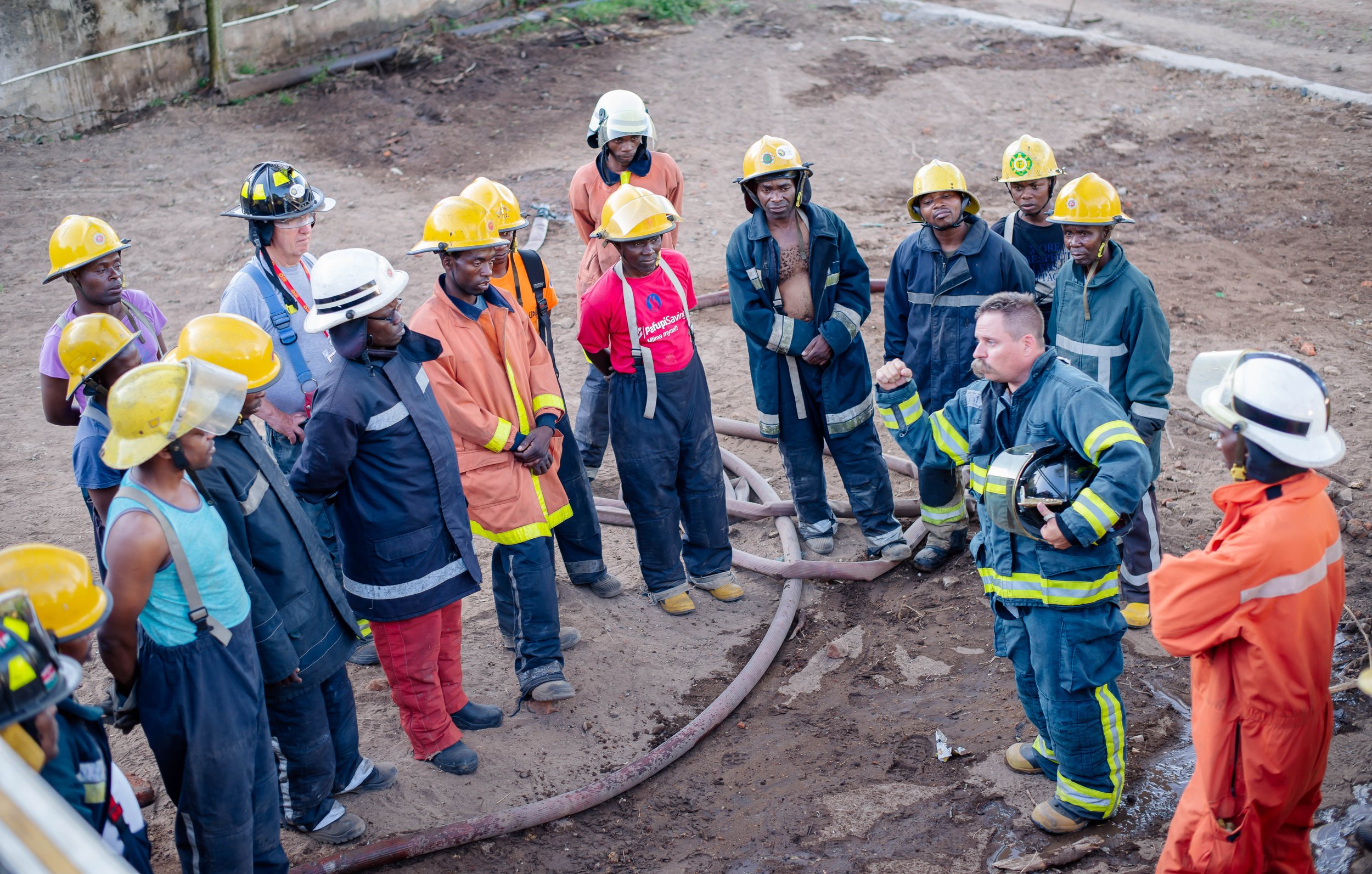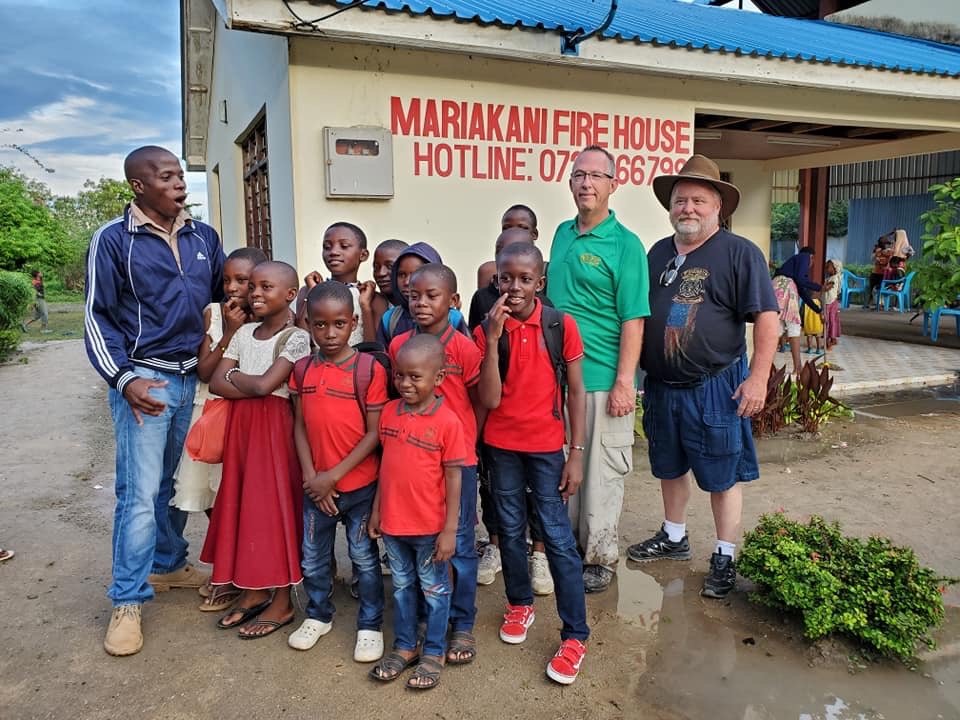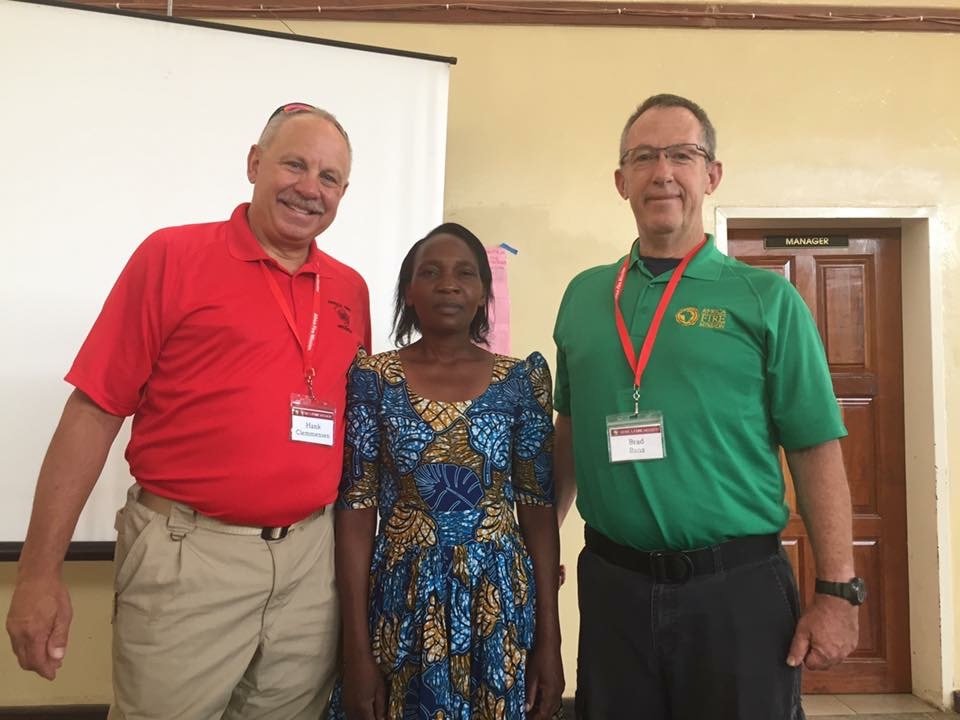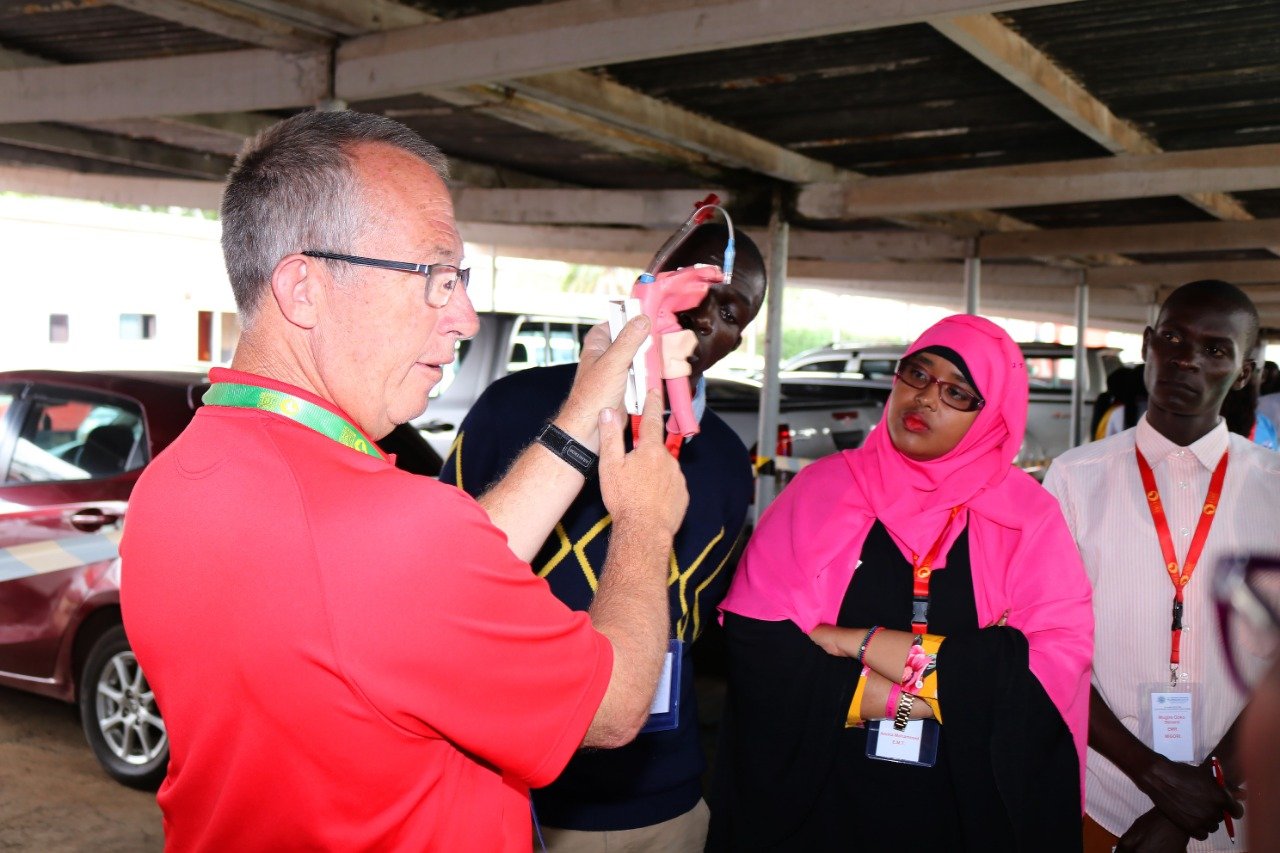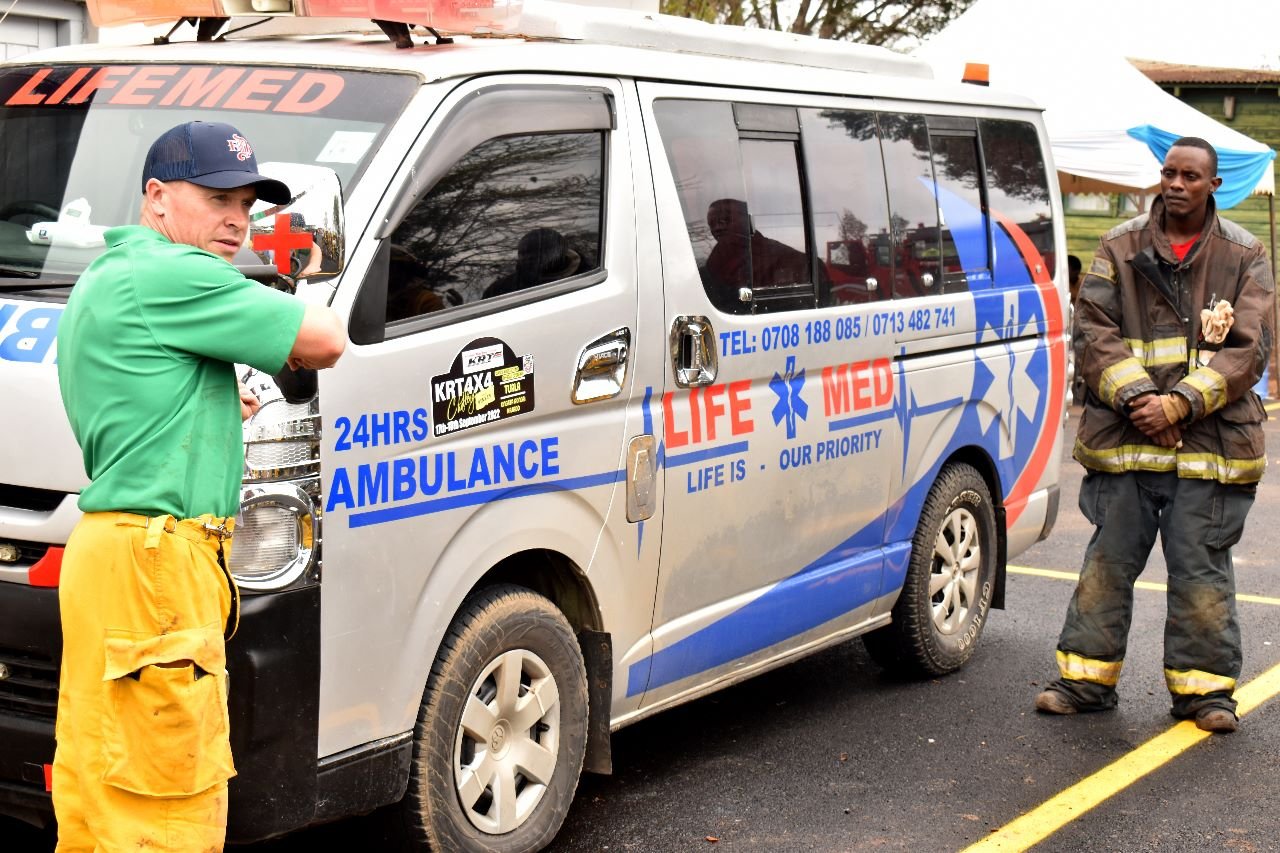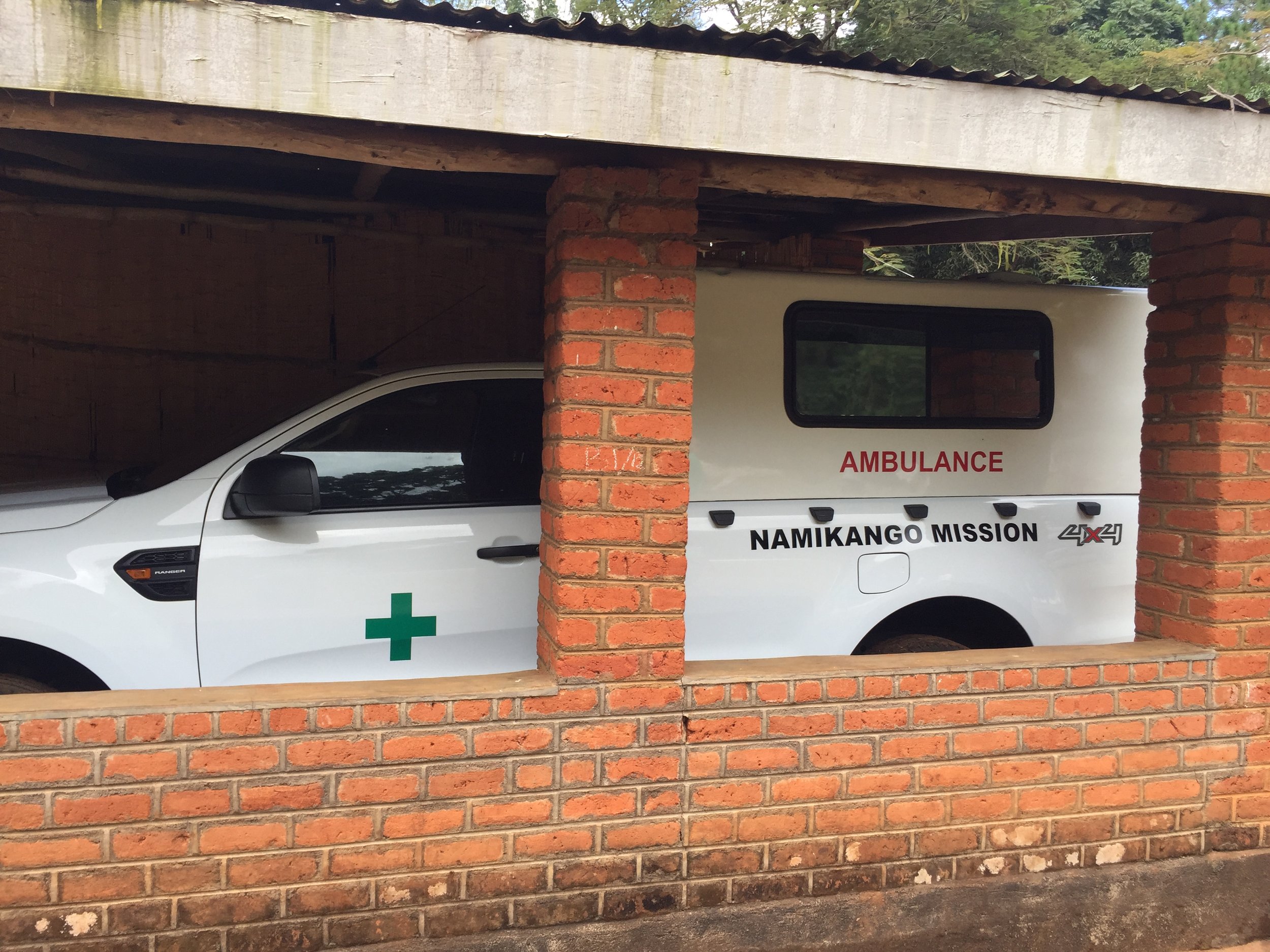We would like to recognize the different award winners from this year’s symposium to highlight the ever-growing fire service in Africa and the determination of first responders in Kenya and beyond.
Highlighting the 2025 Kenya EMS & Fire Symposium and Competition
The Impact of Leadership Training on County Fire and EMS Services
“The 2025 Fire and EMS Symposium at Bandari Academy in Mombasa provided an excellent platform for counties across Kenya to strengthen their emergency response capacity. As an instructor in the leadership class, I witnessed the dedication of Kenya’s firefighters and paramedics first-hand and saw the critical need for strong, ethical, and modern leadership within the sector.”
Suleiman Adan Issack, Chief Fire Officer of Mandera County, writes about his experience at the 2025 Kenya Symposium
An Introduction to the Principles of Emergency First Aid for Firefighters
by Howard Cohen
Not all firefighters are emergency medical technicians or paramedics, but we often serve as the first responders at scenes requiring life-saving first aid. Therefore, it is vital for all firefighters to possess at least a basic understanding of first aid. This short article aims to outline foundational principles for addressing trauma in situations where immediate life-saving medical assistance is needed. This article should not be seen as comprehensive first aid training. Nevertheless, with the basic and limited information provided here, and without any formal training, you may still have the opportunity to save someone’s life.
Scene Survey: The First Task
Size up: Regardless of your level of technical first aid training or medical knowledge, your first task when responding to an incident involving injuries is to gather as much information as possible about the situation. This is achieved through a thorough size up. It is crucial to assess the risks and dangers before rushing in to provide aid. Ask yourself, “What is trying to kill or harm me?” Is it traffic, wildlife, fire, an unstable building, falling objects, or floodwaters? You do not want to become another casualty or cause further harm to the patient.
Number of patients: Once you’ve ensured the scene is safe and stable, it’s time to determine how many individuals are involved in the incident. It’s easy to focus on patients who are crying out in pain and overlook those who are unconscious or not visible. Additionally, it can be tempting to rush to assist a person whose injuries seem more life-threatening than they actually are, such as someone bleeding from a superficial head injury, while another individual nearby has stopped breathing.
Primary Survey: The Second Task
The primary survey is an assessment of the three essential life-supporting functions: the respiratory, circulatory, and nervous systems, often called the ABCDs. Any problems related to these systems present an immediate risk to the patient's life and must be addressed without delay.
ABCDs: Once the size-up is completed, the scene is safe (or as safe as you can make it), and you have a sense of the number of patients needing aid, initiate a primary survey of the patients by checking the status of the three conditions that represent an immediate threat to life.
Airway: Check to make sure that the mouth and airway are cleared and that air is actually going in and out.
Blood is circulating: Ensure that blood is not spilling out and that it is actively circulating.
Disabled: Check whether the spine is stable and the central nervous system is functioning normally. Due to the limited scope of this article, I will not discuss further injuries related to the head, neck, or spine.
Active Bleeding Control Instructor checks the pulse and applies bandages to a patient.
Basic Life Support (BLS)
Basic life support (BLS) is the immediate treatment of one of the three life-threatening emergencies found during your primary survey. Its purpose is to provide temporary support to keep the patient alive while a secondary survey is conducted and/or until advanced treatment is available.
The simplest way to begin a primary survey is to ask the patient, “How are you?” If he answers, you know that his airway is not obstructed (A), his heart is beating (B & C), and his brain is functioning (D). If the patient does not respond or responds in an unusual way, you will need to look more closely.
Airway:
Airway problems result from an obstruction to the pharynx or larynx, which can be complete or partial. A complete obstruction is rapidly fatal, but it can be effectively and dramatically treated by clearing the airway. There are various ways an airway can become obstructed, such as vomit, a foreign object, swelling caused by trauma, an irritant, or an allergic reaction. It is imperative that you clear the airway, but you must do so without causing any additional harm to the patient.
Breathing:
A person can have an open airway yet still experience difficulty breathing. This may result from an injury to the brain, spinal cord, or diaphragm. The method for assisting a patient with breathing when more advanced medical care is unavailable is known as positive pressure ventilation or artificial respiration (mouth-to-mouth). The inflation rate should be around 12 breaths per minute or one every 5 seconds, with each breath lasting about 1 to 1.5 seconds. Rapid breaths can push air into the stomach, potentially leading to vomiting.
Bleeding & Circulation:
Uninterrupted blood circulation is essential for survival. There are two primary types of disruptions to blood circulation that a first responder can address: cardiac arrest and bleeding. Cardiac arrest occurs when the heart stops beating. During your primary survey, if you discover that the patient has no pulse, it indicates that her heart has stopped beating, and she is in cardiac arrest. It's important to note that in adverse situations, or if the patient is in shock, finding a pulse can be challenging. The carotid pulse is the strongest and easiest to access; it is located on either side of the larynx in the neck. If there is no carotid pulse, the heart is not beating. CPR (cardiopulmonary resuscitation) is the only treatment for cardiac arrest. Even with hands-on training, it has limited potential to restore and sustain life.
The second type of disruption to circulation results from significant blood loss. Controlling blood loss is essential as part of BLS. Bleeding can be internal, which is often difficult to identify and stop, or external, though it may not always be obvious. Addressing internal bleeding goes beyond the scope of this article and the capabilities of most first responders in the field. External bleeding is managed by applying direct pressure to the bleeding site with your hand, ideally using a cloth or bandage. This application is not intended to absorb the blood; instead, it provides uniform pressure across the wound. Prepare to maintain direct pressure for ten minutes or more. If the bleeding does not stop, remove the bandage to locate the source of the blood and then reposition your hand.
There is no easy rule for determining when bleeding is severe. A rule of thumb is that if it looks like a lot of blood, it probably is. However, severe bleeding can be missed if the patient is wearing a lot of clothing or the blood is absorbed into the ground around the patient.
Conclusion:
Firefighters practice safely transporting an injured person.
When developing first aid skills, like all skills a firefighter must master, training and practice are essential. Additionally, reading about the principles and theories that support these skills is important. However, there is no substitute for training and practice.
For more information, visit the following references:
Africa Fire Mission Active Bleeding Control Resources
The Outward Bound Wilderness First-Aid Handbook; Jeff Isaac & Peter Goth.
The Field Guide of Wilderness & Rescue Medicine; Jim Morrissey & David Johnson.
Opening an Unconscious Patient’s Airway with a Manual Manipulation
Howard A. Cohen was a volunteer firefighter for 20 years. He began his firefighting career as a chaplain and retired as the deputy chief. He is currently AFM’s online program content director. He frequently presents for the Weekly Virtual Firefighter Trainings and contributes to the AFM blog.
Advancements in Mombasa's Fire Department
by Ibrahim Basafar
My name is Ibrahim Basafar, and I serve as the County Chief Fire Officer for the Mombasa County Government. I am also a PhD finalist in Law Enforcement and Legal Justice Systems at Mount Kenya University.
I recall joining the fire department from the Inspectorate department when His Excellency Abdulswamad Shariff Nassir was elected as the Governor of Mombasa County.
During a visit to the main fire station in October 2022, I was quite surprised by the conditions. There was no dedicated CFO office, recreation center, or classroom. The dormitories were in poor condition, infested with bed bugs, and lacked basic amenities like paint or fans.
The station was operating with only one functional fire engine with an unstable and leaking tank. Additionally, there were broken and leaking fire water hoses, no FFF foam, no allocated fuel, and a lack of essential protective gear such as fire tunics and breathing apparatus. There was also no established curriculum, control room, OB facility, or operational system in place. Sadly, the station had become known as a place to transfer officers with disciplinary issues from other departments.
Governor Nassir and I agreed that the fire department had been neglected and needed a complete transformation into a model department for other county and national entities to learn from. Our initial focus was on enhancing the capacity and discipline of our officers. Following this, we successfully increased the annual budget allocation for the fire department.
Today, we have 102 fire officers who have received comprehensive training in firefighting techniques, OSHA standards, first aid, and water rescue, along with internal supervisory training. Mombasa now has an Emergency Operation Center, overseen by a Fire Officer, which manages county-wide disaster and emergency responses. We have five operational fire engines and one rescue truck equipped with all necessary tools, including extraction equipment for road traffic accidents. All dormitories have been renovated, and the three main stations in Likoni, Changamwe, and Mvita have been refurbished to meet a standard fire department aesthetic.
Currently, we have 60 new, UK-standard fire tunic suits acquired by the county (not donated), 54 self-contained breathing apparatuses, UK-standard fire water hoses with branch nozzles, and a storage of 10,000 liters of AFFF foam. Continuous daily classes are conducted in all three stations using a standardized fire curriculum. Furthermore, a new fire station in Kiembeni is nearing completion at 85% and is expected to be fully operational by June 2025.
We have also extended our training to other counties and institutions, including 60 officers from Kiambu County Fire, 40 from Nairobi, 98 from Tana River (including Chief Wako), 300 individuals from various universities and colleges, and 220 ongoing trainees at the Mombasa Inspectorate school. In 2024, we conducted 52 school inspections and training sessions, as well as 50 community awareness programs.
Presently, 50% of our officers are fully equipped with standard fire tunic suits, boots, helmets, self-contained breathing apparatuses, and working uniforms.
With the continued support of His Excellency Abdulswamad Shariff Nassir, we are optimistic about achieving 100% PPE for the remaining officers in the next financial year. We also aim to build an additional fire station in Nyali, initiate a kitchen welfare program for our firefighters, and implement promotions for the existing force.
It truly makes our day when our firefighters return home safely with a sense of accomplishment.
Chief Fire Officer Ibrahim Basafar is Mombasa County Government’s Fire Chief. He is a PhD Finalist in Law Enforcement and Legal Justice Systems at Mount Kenya University. He is an experienced Fire Officer and safety expert.
“It’s incredible to see the advocacy and advancement taking place in the fire service in Mombassa. Collaboration, relationships, advocacy, and tenacity have been required to improve Mombassa’s fire service. We hope that other fire services in Africa can learn from what Mombassa is doing!”
- Nancy Moore, Africa Fire Mission, Executive Director
AFM Launches Active Bleeding Control Program in Kenya
In March 2025, Africa Fire Mission (AFM) proudly launched our Active Bleeding Control Program in Kenya, a significant step toward enhancing emergency response capabilities in the region. This initiative addresses the critical need for immediate bleeding control, especially in areas where access to medical facilities may be delayed.
Growing Mental Wellness Programs
By Chief Mike Kull =- Programs Director, Africa Fire Mission
Africa FIre Mission held its annual All Kenay Fire and EMS Training Symposium in November 2024. AFM integrated discussions about mental health and wellness into all of the training classes that were offered. This topic is frequently requested and is especially relevant due to first responders being attacked while trying to lend assistance to the public during 2024 demonstrations in Kenya.
Mental health issues are often stigmatized, particularly among first responders and various communities across Africa, where such challenges are frequently perceived as signs of weakness. This stigma can lead first responders to fear ridicule or ostracism from their peers when confronting mental health or addiction problems. Such concerns are compounded by stories of alcohol abuse within the ranks of first responders, highlighting the urgent need for open dialogue and support.
To combat these stigmas, our training classes fostered a supportive environment where participants could learn, share, and hear the experiences of others. AFM’s instructors lead discussions and recounted their own journeys with mental health and wellness. This, facilitated open discussions that underscored the importance of mental wellbeing and talking about trauma and its impact. Wellness exercises, including mindfulness and physical exercise, were integrated into the program to promote holistic approaches to mental health.
Feedback from participants indicated that these interactions proved invaluable; one firefighter expressed gratitude to an instructor, sharing his battle with alcoholism and his triumph in achieving sobriety since the training began. Additionally, training participants reported that the sessions significantly broadened their understanding of the stress and trauma that first responders endure. Chief Fire Officers, expressed that they gained renewed insights into the struggles faced by their team members, affirming the need for continued support and open conversations surrounding mental health challenges in high-stress professions.
The Importance of Wearing Your Personal Protective Equipment as a Firefighter
by Mark van der Feyst
Personal Protective Equipment (PPE) is essential for all firefighters. PPE for firefighters is not only required, but it is extremely important as it protects them from many dangers that they will face within the scope of their job. Some of the dangers that firefighters will come across within their job include heat and flames, hazardous materials, injuries, burns and possible death. While safety is the main reason why proper PPE should be worn, they are needed by firefighters to prevent them from inhaling hazardous fumes, toxins, and debris that could harm their lungs, respiratory system, as well as a shield to prevent the skin from absorbing harmful toxins and particles that might otherwise lead to chronic health conditions.
Firefighter helmet and boots
Firefighter's PPE, also known as turnout gear or bunker gear, is a critical component as it is made with different layers of fabric for optimal fire protection. The outer and thermal layer protects the firefighter from radiant heat, and it can also serve as protection from partial flame. The moisture barrier serves as a protection from the sprayed water to prevent the body from getting soaked, thus saving them from injuries due to steam burns. The gloves and boots that firefighters wear are made from fire-resistant materials to protect their hands and feet from sharp objects, radiant heat, and other dangers that might occur. The helmet is made from durable and fire-resistant materials as well as it includes a mounted flip-down shield to protect their heads and faces from extreme temperatures and falling debris. Likewise, it also prevents the firefighter from getting drenched from the sprayed water. The PPE also includes a face mask, air pack, and an air cylinder so that they are able to regulate air pressure and breathe clean air.
The proper fit of a firefighter's PPE is crucial to their safety as well as endurance. PPE that fits properly enhances the firefighter's ability to carry out their duties effectively while minimizing the risk of accidents and injuries. Gear that is not fitted properly can impede movement, restrict flexibility, and compromise overall functionality, posing potential hazards on the fire ground. Firefighters who are properly protected have a greater chance of survival than those who are not.
In addition to wearing PPE correctly, proper cleaning and maintenance of this gear is also essential. Carcinogens are present on the fireground so as a carrier of contamination, wearing inadequately cleaned or uncleaned PPE results in the transfer of that contamination to any surface or person the firefighter encounters. The equipment should always remain in good condition and be ready to be worn for the next emergency.
PPE is the only equipment that is used in every emergency. Wearing the appropriate PPE is heroic. A firefighter cannot help or save someone else if they themselves are hurt, injured, or worse, dead. Simply put, PPE is as important a tool as anything else in the fire service.
Mark van der Feyst has been in the fire service since 1998, currently serving as a firefighter with the Fort Gratiot Fire Department in Michigan. He is an international instructor teaching in Canada, the United States, and India. He is a veteran of two AFM trips to Kenya.
Recognizing the 2024 Kenya Fire and EMS Symposium Award Winners
In November, Africa Fire Mission worked with partners and collaborators around the world to hold the 2024 Kenya EMS and Fire Symposium and Competition. This Symposium featured firefighter and EMS trainings, leadership development, mental health awareness, community fire prevention trainings, and the signature EMS and Fire Competition. All of the classes were desinged to have immediate application for firefighters and EMS personel. AFM was espeically focused on leadership development in emergency services and the mental, physical, and spiritual wellness of first responders. AFM would like to recognize members of the fire service who are making a difference across Africa, as well as the award winners of the Fire and EMS Competition!
Africa Fire Mission Receives Motorola Solutions Foundation Grant
Africa Fire Mission (AFM) is pleased to announce that it has received a grant from the Motorola Solutions Foundation, the charitable arm of Motorola Solutions. AFM will use this grant to support the funding for our Fire and EMS Training Symposium and Personal Protective Equipment (PPE) Distribution in Kenya. This event serves as an incredible opportunity to train members of the fire service and develop leaders. AFM team members will also prioritize the mental wellness of first responders by continuing the development for health and mental wellness programs for emergency personnel.
Press Release: AFM Receives Grant Award from the Laerdal Foundation for Stop the Bleed® Training Program
Africa Fire Mission (AFM) announces a grant award of $44,000 from the Laerdal Foundation for research to begin a Stop the Bleed® training program in Sub-Saharan Africa. The project will be led by Nancy Moore, MSW, LISW-S, Kirstin Henley, MD (Baylor College of Medicine), and Africa Fire Mission volunteers beginning November 2024 in Nairobi, Kenya.
Water Rescue Safety Information
by Tyler Prater
Water rescue operations are a very dangerous, highly technical operation. With water covering over 70 percent of our world, as first responders we are bound to respond to a water emergency. One of the biggest hazards is flash flood and swiftwater emergencies. Swiftwater is described as water moving more than 1 nautical mile per hour (Knot). NFPA 1006 standards breaks swiftwater rescue into 3 parts.
1. Awareness, meaning that the responder is aware of the hazards but is not trained to mitigate.
2. Operations, meaning that responders can take a defensive role using throwbags or throwable flotation and have been trained in self rescue defensive swimming techniques.
3. Technician level training, meaning that the responder is equipped and properly trained to respond to in water emergencies using a “Go” rescue.
It's also important to note the water rescue order of operations. Remember the saying “Reach, Throw, Row, Go.”
Reach - To reach for the victim trapped in the water. Long Sticks, ladders, poles, or anything sturdy enough to reach into the water to get to the victim.
Throw - Throw a rope or a flotation device to your victim trapped in the water.
Row - Use a boat to row your way to the victim.
Go - The most dangerous and last resort in water rescue: to send a rescue swimmer into the water.
As in all rescue operations, PPE is an especially important factor for water rescue. Making sure anyone operating near the water knows how to swim and has proper flotation in place. If making a “Go’ rescue it is imperative that the PFD the rescuer is wearing has enough flotation for both the rescuer and the victim. When responding to emergencies in fire apparatus, remember that we are not invincible to the power of water. It only takes a few inches of water to float and move a vehicle. Turn around, don't drown. Flood water is also a known health hazard. As water floods a village or city it picks up all waste and hazardous materials and flows it across the city. If vehicles or sewage facilities are involved, fuels and biohazards could enter the water. Treat all flood water as hazardous water and make sure to thoroughly decontaminate your body and all equipment used in the water. Multiple bystanders die each year trying to rescue victims in flood water. Tying yourself to a rope that you cannot break free from is also another hazard that is commonly misunderstood. If a rope is tied around a rescuer and that rescuer gets hung up, or reaches the end of the rope the power of the current will push the rescuer under the water.
Understanding and treating water rescue events as a high hazard, low frequency event will make both the rescuer and victim safer in the long run. Public education of the hazards of flash flood and swiftwater hazards is also imperative to preventing water emergencies. Remember to follow your level of training. Rescuers must have the appropriate PPE and resources available to make an in water rescue. For more information on this topic and to learn more about training standards, reference NFPA 1006 - Professional qualifications of technical rescuers, or check out TDISDI.com / ERDI and search for swiftwater rescue.
Tyler Prater is a 8 year member of the St. Louis Fire Department and currently serves as a rescue squad member. Tyler is also a water rescue specialist and instructor for Water and Dive Rescue.
Serving In Nigeria with FCT Fire Service and IHVN
It was great to be back in Abuja, Nigeria in January and early February!
An AFM team of six provided training to FCT firefighters, IHVN staff and partners from the “Committee of Stakeholders on the General Safety & Security of Cadastral Zone C00 Abuja FCT.” The training allowed the AFM team to assess the capabilities of the firefighters as well as gain a better understanding of the community’s perspective of firefighters. Training for the FCT Fire Service focused on enhancing fire response capabilities, promoting utilization of available equipment and tools for firefighting, and enhancing community awareness.
Team member Mike Kull elaborated that “we were able to provide quality training on a wide variety of topics - Breathing Apparatus, Ladders, Hose Drills - Firefighters from FCT Fire Service were eager to learn and we expect to see rapid and positive results from this training. We realize that development is a slow process but we have high hopes for the firefighters here in Nigeria.”
Head of Operations, FCT Fire Service, Engr. Adesina Abioye, stated that the training has updated Fire Service Staff with modern professional ways of rescue and firefighting, and served as a refresher course on fire prevention and administration for the Senior Staff who participated. “The importance of the partnership cannot be overemphasized; it has brought tremendous benefits to the partners and the stakeholders community. What would have cost the FCT administration a huge sum of money was made available at no cost due to partnership,” he said.
AFM also conducted a needs assessment to identify tools and equipment needed to further develop the FCT Fire Service and donated firefighting equipment. This equipment included firefighting coats, boots, gloves, suspenders and helmets for enhanced effectiveness in responding to fire incidents and saving lives, property, and critical infrastructure.
We are grateful that IHVN is committed to collaborating with FCT Fire Service to enhance the capabilities of the fire service and look forward to continued collaboration in Nigeria.
The Five C’s of Radio Communications
The Five C’s of Radio Communications
by Mark van der Feyst
The essential elements of effective incident scene communications fall into five categories. Understanding these attributes of successful communication and engaging in the suggested strategies will enhance your communication effectiveness, as well as that of the overall communications on the emergency incident scene. These are known as the Five C’s of Radio Communications: Conciseness, Clarity, Confidence, Control and Capability.
Conciseness
· Keep the messages short and concise. This will help in reducing radio traffic.
· Keep the messages specific. Think about what you want to say before you speak and then say it.
· Condense the message as much as you can while still keeping it complete. This will help in eliminating any confusion by the receiver.
Clarity
· Use standard terms as defined in your department’s procedures. This will avoid any confusion on the incident scene.
· Use plain-text language in all radio communications. Avoid using ten-codes, acronyms, or technical jargon.
· Avoid multitasking. Describe and assign one task at a time to company members. Do not overload a company with multiple tasks to be completed at one time.
Confidence
· Communicate on the radio in a calm manner. This helps to maintain calmness on the incident scene and does not create or add to hysteria.
· Be audibly received. Speak in a voice loud enough to be heard by the receiver. Do not speak in soft tones or yell into the radio. Yelling will distort the message, whereas speaking too softly will require repeating of messages.
· Use a good vocal pitch to communicate. This will help to be audibly received. Having a high pitch or a low pitch will have the same impacts as in the previous point.
Control
· Take control of the radio communications on the incident scene. Follow established departmental procedures and protocols.
· Minimize unnecessary radio chatter. Prioritize messages to be sent and received.
· Keep your emotions in check. This will help with establishing confidence and allow for more sensible direction to be given.
Capability
· Use active listening skills. Be sure to hear all the messages that are being transmitted to you. This may require being in a quiet place versus being outside near a working engine.
· Know how to use the communications equipment. Know where to hold the radio or microphone in relation to your mouth, SCBA face piece, or other radios nearby that may produce feedback.
about the author: Mark van der Feyst has been in the fire service since 1999 working in both Canada and the USA. Currently he works for the Fort Gratiot Fire Department in Michigan after taking early retirement from his career department at the end of 2020. He is an international instructor teaching in Canada, USA, India and many large and regional conferences such as FDIC, Firehouse World & Expo. He holds an MS in Safety, Security & Emergency Management from Eastern Kentucky University and has been providing virtual training sessions for Africa Fire Mission for two years.
Why should fire trucks and ambulances always show up for a medical emergency?
Why should fire trucks and ambulances always show up for a medical emergency?
By Kelvin from Swift Emergencies Response Unit - Kenya
When a call comes in at the call center, dispatchers often are not given precise or complete information. As such, units are dispatched on a worst-case scenario. To ensure the highest level of care, the closest fire engine station is dispatched and EMS sends an ambulance (staffed with two paramedics and/or EMT's).
No medical call is “routine.” Most require assessing the patient, obtaining their vital signs, providing oxygen therapy, and moving them, at a minimum. EMS may also need to place an advanced airway, administer drugs intravenously, or monitor cardiac conditions. All of these procedures are completed more efficiently when the appropriate amount of help is on scene. Efficient care is our goal, and efficient care often is the difference between life and death.
Unfortunately, units have no way of knowing what they will encounter on a call until they arrive. They work in a “what if” and “all risk” business. Responding to the unknown is public safety. The public can help by calling emergency numbers quickly when there is an emergency and providing details of the emergency. Emergency hotlines are your instant go-to when the need arises. It is important that you know the numbers to call to get assistance and keep a copy with you.
Celebrating our Volunteers!
On October 14, 2023 during our Annual Fundraiser, the Chama, Africa Fire Mission will honor volunteers Chief Bradley Banz and Chief Michael Kull.
Volunteer of the Year
Africa Fire Mission thrives on volunteers. Volunteers are at the heart of our organization. We have dozens and dozens of volunteers. We have volunteers from all across the North America, Africa and Europe that help allow AFM to serve on a daily basis. These men, women, firefighters, civilians and children are all a vital part of Africa Fire Mission being able to achieve its goals and objectives.
Chief Michael Kull – Volunteer of the Year
Chief Mike first joined Africa Fire Mission team in 2021 and has been all in with us ever since. Mike has participated in missions to Kenya and Malawi and facilitates AFM’s weekly virtual trainings. This past year, Mike stepped further into leadership co-leading our Malawi training trip! Mike just get’s it. He understands that the fire service in Africa is limited in physical resources and rich in people resources! Mike uses his creativity to help solve problems and helps the fire service advocate for what they need. This week we learned that the Zomba, Malawi fire brigade received its first uniforms from their local government as a result of the advocacy that their team learned from Mike. Mike’s dedication to facilitating our online trainings and lead to steady growth of our trainings from 60 participants a week at the beginning of 2023 to more than 100 participants a week now.
Mike fully embodies our mission to train, empower, support and encourage firefighters in Africa and his leadership has allowed us to continue to grow!
Thank you Mike for all that you have done for Africa Fire Mission! We are looking forward to serving with you for year’s to come!!
More about Chief Michael Kull: Chief Michael Kull is from Pennsylvania where he recently retired as the Fire Chief for the Valley Township Fire Department, Forest Fire Warden for Weiser State Forest and as a Township Supervisor for Valley Township. As a volunteer firefighter with over 25 years of experience, Michael has learned creative strategies for meeting his community’s needs for fire and rescue services.
Instructor of the Year
When Africa Fire Mission travels with a team to provide training in Africa or other parts of the world, our team members volunteer their time, talents and treasures to provide world class training to our partners. Our instructors undergo training in advance of the trip to prepare of the mission and prepare the lessons that they will teach in our week long fire training events. We are fortunate to have many instructors return year after year who continue to build each year on the training that they have been providing as well as to build strong relationships with firefighers and our overseas partners.
Chief Bradley Banz, Instructor of the Year
Chief Banz heard about AFM from our partner at Missions Of Hope International after providing CPR and first aid training there. Brad’s been involved with AFM since 2015. Brad has traveled with AFM on missions to Kenya, Zambia, and Malawi. Brad has been instrumental in the development of our Community Health Evangelism curriculum on Fire Prevention and Safety which has impacted millions of lives across Africa. Brad notices needs and responds making sure that curriculum developed for classes he teaches meet the needs of the fire service. This past year, he developed a Hazardous Materials class for firefighters in Africa after seeing the dangers firefighters were exposing themselves to attempting to respond to some Haz Mat incidents.
Brad encourages our team members and advocates for the firefighters. He takes time to get to know the firefighters we are serving and what their needs are. His heart for Africa is abundantly clear!
Thank you Brad for serving with heart and passion! We are grateful to have you on our team!
More about Chief Bradley Banz: Chief Banz is a firefighter with over 38 years of experience. Brad retired as a Captain for the Wichita, Kansas Fire Department and retired as Fire Chief from Colwich Kansas. Brad continues to serve his community as a volunteer firefighter in addition to training firefighters in Africa.
Interested in volunteering with AFM in administrative roles or as one of our international instructors?
Ambulance Services and Its Importance in Society
Ambulance Services and Its Importance in Society
By: Kelvin from Swift Emergencies Response Unit - Kenya
Increase in medical ailments has led to the rise in hospitals and emergency medical services assisting patients who require emergency medical assistance at critical moments, helping them to reach the hospital on time thus saving their life.
Private and public ambulance transport services are operating in more numbers today as an inevitable service providing care to critical patients at crucial moments. In Kenya, ambulance operating centers are set up at every hospital and private EMS organization. These Ambulance operating centers function with adequate ambulance transport services to offer immediate medical care for patients. Private ambulance transport services depict a consistent rise in the growth curve each year offering non-emergency services unlike hospital ambulance transport services which primarily function for emergency needs. Some of the non-emergency services include shifting patients from one hospital to another, transporting patients for any scanning or laboratory services to the relevant facilities, or patients with any travelling disabilities in normal vehicles to hospitals for treatments.
Emergency ambulance services are usually equipped with adequate medical equipment and paramedical professionals. Sometimes, non-emergency ambulance transport services are also equipped with some basic medical aids and a para medical staff to cater the needs of immediate medical care to patients.
Let us discuss a few points about the pre-hospital medical professions - paramedics and emergency medical technicians (EMTs) who are the spine of ambulance transport services:
Paramedics or EMTs are first treating patients even before doctors (pre-hospital care) thus saving patients through immediate medical procedures ensuring the vitals stable before reaching hospitals for further treatments.
Paramedics and EMTs are trained healthcare professionals, authorized to attend patients with required medications and procedures based on their training level.
Education level, standards, functions and skills of paramedics and EMTs vary with countries. However. certain standard functionalities remain common such as being trained to practice CPR procedures for cardiac arrest patients, usage of defibrillators, certain analgesic, paralytics and sedative medications for pain control, first aid to treat burns, fractures, childbirth complications, spine injury, airway management, blood control etc.
One should respect the noble service of prehospital providers who form an integral part of ambulance services.
The youth of our nation should involve themselves in such noble service, joining community life saving teams and can considering a career as a paramedic or EMT.
The government could benefit from taking initiatives to support volunteer community first responders at the community level and to empower them to continue saving lives at the scene before qualified personnel arrives.
The EXIT Project: Using U-STEP OUT Principles in Vehicle Accidents
Many patients will require extrication following a motor vehicle collision (MVC) however, little information exists on the time taken for the various stages of extrication. Dr. Tim Nutbeam, Rob Fenwick and their research team conducted research on the time it takes to extricate a patient and the positive results reducing time for extrication may have on their health.
The EXIT Project - Using U-STEP OUT Principles in Vehicle Accidents
by : Dr Tim Nutbeam and Rob Fenwick
In this article we will be taking a look at the USTEP Out protocol, which is a self-extrication practice. If you are unfamiliar with the EXIT Project watch this video and then continue reading here. Before discussing the USTEP Out protocol, we will look the supporting research. Recent research shows that rescuers should reduce extrication times. This can be done by recognizing that the old protocol (the absolute spinal movement minimization approach) was evolved due to a concern that excess movement may lead to avoidable secondary spinal injury, was never justified.
Further that this approach should instead be replaced – where it is in accordance with your rescue organization’s clinical governance – with:
1. an emphasis on rapid self or assisted extrication
2. and where this is not initially possible, the timely creation of minimum safe space through which the trapped person can subsequently self-extricate (or be extricated by rescuers focussing on the minimization of time rather than movement)
Process
With regard to rapid self or assisted extrication, the EXIT Project’s U STEP OUT protocol is detailed below, with example photos and commentary to follow:
1. U – Understand
While rescuer protection is paramount, if it is safe to do so a rescuer should raise their visor and lower any mask, thus facilitating effective communication with the patient. This is allow verification that the patient is fully responsive and that they understand their circumstance.
It is important that from the outset the rescuer allocated to support the patient explains to them what is going on and their method of extrication. The rescuer should listen to and manage the patients concerns and offer verbal guidance, as well as emotional and physical support as they leave the vehicle.
2. S - Support
Many patients who are capable of self-extrication will do so immediately after the collision. If they are capable but have chosen not to do this, then they will likely require a rescuer’s reassurance that they will be safe if they do so. The patient should agree to the plan, but the rescuers must be aware that they may change this preference and if so, be able to manage this.
3. T – Try moving
Ask the patient to move both their legs, if they cant they wont be able to self extricate
4. E – Egress
The door must be fully opened - consider the need to force it away from the patient if doing so will assist safe movement. Both the exit space and the identified egress path must be clear of all trip hazards and obstructions.
5. P – Plan
Determine where will the patient go on exit and ensure that a suitable means of support is available and nearby.
6. OUT
Offering an arm, with the patient using it to support their own movement is very low risk, compared to actively pulling the patient out of the vehicle.
Conclusion
The use of self or minimally assisted extrication will depend on the decision of the lead rescuers as to whether this option best suits their patient’s medical circumstances and needs.
The simple U STEP OUT protocol can be easily understood and used by all rescuers and will minimize patient entrapment time which will help ensure their earliest arrival to a medical care facility.
Using EXIT Principles in Motor Vehicle Accidents
Many patients will require extrication following a motor vehicle collision (MVC) however, little information exists on the time taken for the various stages of extrication. Dr. Tim Nutbeam, Rob Fenwick and their research team conducted research on the time it takes to extricate a patient and the positive results that reducing time for extrication may have on their health.
The EXIT Project - Using EXIT Principles
by : Dr Tim Nutbeam and Rob Fenwick
In this article, we are going to take a brief look at the main EXIT Principles – identified during Evidence Based Research in the UK – and from two different perspectives. We’ll also see how these principles can be put in Practice. Find out more here.
The Rescuer’s Perspective
The main principle identified in the research study was that rescuers should reduce extrication times by recognizing that the patient movement minimization approach (MMA), which focuses on potential damage to the patient’s spinal cord, was never justified.
The research findings point to the idea that MMA should be replaced with a primary emphasis on rapid patient self or assisted extrication, if medically appropriate and where they can follow instructions and also move their legs.
Where this is not the case, they should be extricated by rescuers focussing on the minimization of time rather than movement, with the creation of the minimum necessary safe extrication space.
In terms of clinical care, this latter practice is facilitated by :
- medical and fire rescuers working together to develop and manage a patient centred extrication plan
- medical and fire rescuers being aware that frequent stops for medical observations will extend the extrication time, thereby delaying arrival at hospital and so should be kept to a minimum
- limiting care to only the clinical interventions necessary to allow safe extrication.
- medical and fire rescuers being aware of the signs of patient deterioration and notifying the senior clinician if these signs are seen.
The Patient’s Perspective
The principle here is to meet both the physical and emotional needs of the patient. The EXIT researchers consulted with past trauma patients and found that this often tends to be poor or gets missed, because the main rescuers focus is on (extensive) space creation activities.
In response to these findings, EXIT is a patient-centred practice and allocates a dedicated ‘extrication buddy’ to the patient. Pivotal to the buddy’s role is communication; establishing a connection with that vulnerable person, including being in the car with them, using their name, explaining what’s happening and advocating on their behalf with the rescue team.
The ‘buddy’ should also use clear language, give assurance that any co-occupants and pets are safe and allow patients to call family or other close contacts.
Patient privacy is also important and so limiting the ability of the public to record events (and subsequently post them on social media), perhaps via the Police attendance, may be necessary. Note that this restriction also applies to the rescuers and their respective organizations.
Conclusion
The EXIT Principles identify that while we must care for the patient’s needs, where they present with any evidence of injury, that they should be considered as time-dependent and efforts must be made to minimise their extrication time. The quickest way to enable this is assisted self - extrication, as rescuer-extrications can be complex and take longer to perform, and so should only be employed where self-extrication is not feasible.
Confined Space Rescue: Reasons for Technical Rescue Operations Failures
Conducting a confined space rescue is a risky endeavor that requires great skill and patience.
Many times we have seen numerous rescue attempts fail due to the lack of patience and skill
being exercised by rescue personnel. In training of technical rescue operations, we instruct
upon how we want to avoid a failed rescue attempt by recognizing certain attributes that are
lending to the overall situation. The acronym FAILURE is used to describe these certain
attributes that can be present at each confined space rescue operation. The acronym FAILURE
stands for:
F – Failure to understand the environment
A – Additional medical implications not considered – dust, crush syndrome
I – Inadequate preparation
L – Lack of team work, training
U – Underestimating the logistical needs
R – Rescue vs. Recovery
E – Equipment not mastered
The first important consideration of the environment is the atmosphere inside and around the
confined space. Monitoring the atmosphere is sometimes overlooked by responding personnel
and thus leads them to become victims as atmospheric conditions overtake. The basic four gas
monitor will be a benefit as it will detect for percentage of oxygen, carbon monoxide, hydrogen
sulfide gas and lower explosive limits. Ideally, conditions should be 0 % for hydrogen sulfide, 0%
for carbon monoxide, 0% for LEL and 21% for oxygen. An increase/decrease of 1% in any
category is equivalent to 10,000 ppm of a contaminant in the ambient air. Even though there is
just a 1% difference between normal and acceptable limits, doesn’t mean that it is safe to
enter. Using hydrogen sulfide as an example, it only takes between 1000 to 2000 ppm to cause
death in a few minutes which is less than 1%.
The letter “A” represents a lack of consideration for additional medical implications that are not
being considered. The majority of confined space rescues involve a person who is overcome by
a toxic environment or a lack of oxygen within the space. Very few incidents involve medical
reasons as the catalyst for the rescue operation. When we think of medical reasons we are
considering falls, traumas, and cardiac arrest. These types of incidents represent a very low
number of why we have a confined space rescue. However, when there is a confined space
rescue operation initiated, these factors must be considered and answered.
The letter “I” is in reference to inadequate preparation. What makes a confined space rescue
incident worse is the lack of preparation for the worse to happen. Many workers will enter into
a confined space thinking that it is only another routine day. There has been no time taken to
prepare for the actual rescue of that worker. Gaining entry into a confined space is the easy
part, getting the entrant out of the confined space when something goes wrong is the hard
part. Adequate preparation must be taken to ensure that the question of “How do we get the
entrant out” can be answered before the entrant goes in.
The letter “L” is for a lack of team work. During a confined space rescue incident, there needs to
be one person one charge who will be your Incident Commander. This person will be the one
who will make the final decisions on how to affect the rescue, which person will do what tasks
and oversee the whole operation from start to finish. When you have emotions taking over
certain members of the team, they seem to want to control the operation and start to ignore
the Incident Commander and start to implement what they think is best and should be done. At
this point communications starts to break down, and mistakes start to occur.
The letter “U” is for understanding the logistical needs. It is wise to expect the worse and be
prepared for it rather than being unprepared and expecting the least. Many times rescue crews
are responding to a call not prepared for what they are going to be faced with. For a confined
space rescue incident, the crews responding need to expect the worse. This way they will be
prepared when arriving and ready to act without hesitation.
The letter “R” is for rescue vs. recovery. Establishing the mode of operation at the onset of the
effort is vital to the success of it. The Incident Commander needs to determine right away
whether they are going to be conducting a rescue or a recovery. This determination will set the
pace of the operation and it needs to be communicated to everyone on site very clearly..
Would be rescuers soon become the victim as they are overcome by toxic atmospheres found
within the space. According to statistics from NIOSH, 60% of confined space fatalities are would
be rescuers.
The letter “E” is for equipment not mastered. Confined space rescue teams use lots of different
equipment to aid them with their operations. The equipment used needs to be mastered by all
those who are expected to use it. This only occurs through training and practicing with the
equipment on a regular basis. The time to learn how to use a certain piece of equipment is on
the training grounds and not at the confined space incident.
About the Author:
Mark van der Feyst is a 25 year veteran of the fire service and is currently the Senior Battalion Chief at the Six Nations Fire & Emergency Services in Canada and a part time firefighter with the Fort Gratiot Fire Department in Michigan. He has worked in both the USA and Canada for various fire departments and holds a Masters of Science degree in Safety, Security & Emergency Management from Eastern Kentucky University.

